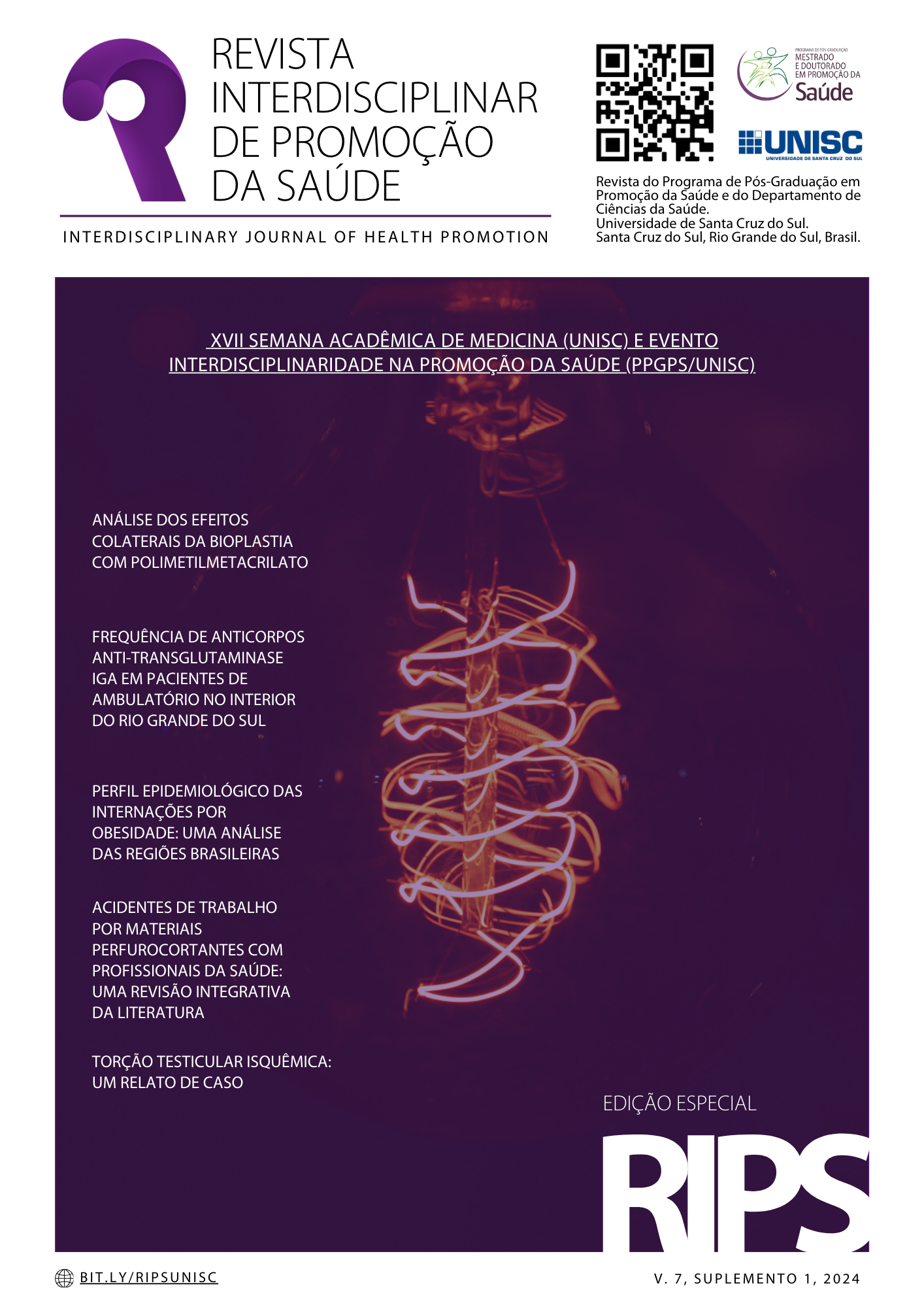Analysis of side effects of bioplasty with polymethylmethacrylate
DOI:
https://doi.org/10.17058/rips.v7isuplemento.18964Keywords:
Polymethyl Methacrylate, Plastic Surgery, Adverse ReactionAbstract
Introduction: the aging of the skin, with the loss of fat and collagen, has led to the growing
popularity of permanent fillers. Among them, Polymethylmethacrylate (PMMA), a synthetic
product composed of acrylic microspheres, has stood out in bioplasty procedures due to its
low cost. However, the inappropriate use of this material has become a critical issue in
medical practice due to its possible serious adverse effects. Objective: to analyze the side
effects of bioplasty with polymethylmethacrylate as a permanent filler. Method: integrative
literature review of articles in Portuguese, English and Spanish, published between 2008 and
2023 in the PubMed, Biblioteca Virtual em Saúde and Redalyc databases. The descriptors
were used with boolean operators in the following order: "plastic surgery" AND "polymethyl
methacrylate" AND "adverse reactions". Of the 82 articles found, 7 were selected. Results:
although PMMA is approved by the National Health Surveillance Agency (Anvisa), its
indiscriminate use poses significant risks. The persistence of the product in the body triggers
the release of pro-inflammatory cytokines which initiates chronic inflammation and can also
impair local blood supply, leading to necrosis and the formation of ulcers. As a protective
response, the body generates a fibrous capsule around the PMMA microspheres, causing
tissue retraction and deformities. In addition, the particles of the product can migrate through
the lymphatic and blood vessels and form granulomas in places far from the original
application. Conclusion: the inappropriate and excessive use of polymethylmethacrylate in
bioplasty procedures poses considerable risks and can result in aesthetic and functional
complications that are difficult to reverse in the long term. Therefore, it is essential that
bioplasty with PMMA is performed by qualified professionals, in accordance with the
guidelines of the Federal Council of Medicine (CFM), in order to minimize risks and prevent
adverse consequences for patients.
Downloads
References
Kurimori K, Mendes M, Milcheski D, Monteiro A, Gemperli R. Complicação grave do uso irregular do PMMA: relato de caso e a situação brasileira atual. Rev Bras Cir Plást. 2001; 34(1):156–62. doi: http://www.dx.doi.org/10.5935/2177-1235.2019RBCP0025
Costa ACO, Neves ENR, Castro IB de, Noronha MJS, Machado MC. Complicações com o uso irregular do polimetilmetacrilato e possíveis procedimentos estéticos a serem realizados em pacientes com a substância. PhD Santos NM. Rev e-Scientia 2022; 13(5):1984-7688. Disponível em: https://repositorio.animaeducacao.com.br/handle/ANIMA/31139
Machado RA, Oliveira LQ, Martelli-Júnior H, Pires FR, Carvas JB, Rogerio VE, et al. Adverse reactions to the injection of face and neck aesthetic filling materials: a systematic review. Med Oral, Pat Oral y Cir Buc. 2023 May 1; 28(3):e278-84. doi: https://doi.org/10.4317/medoral.25713
Park TH, Seo SW, Kim JK, Chang CH. Clinical experience with polymethylmethacrylate microsphere filler complications. Aesth Plast Surg. 2011; 36(2):421–6. doi: https://doi.org/10.1007/s00266-011-9803-z
Lehman A, Pilcher B, Roberts WE, Schlesinger TE, Vachon G. Postmarket experience of polymethylmethacrylate–collagen gel dermal filler. Derm Surg. 2020; 46(8), 1086–1091. doi: https://doi.org/10.1097/DSS.0000000000002222
Rosendy G, Cavalcante IL, Barros CC da S, López-Labady J, González N, Pérez-Alfonzo R, et al. Adverse reactions associated with dermal fillers in the oral and maxillofacia region: a Venezuelan experience. Head and Neck Pat. 2023; 17(3):631–7. doi: https://doi.org/10.1007/s12105-023-01563-9
Atiyeh B, Ghieh F, Oneisi A. Safety and efficiency of minimally invasive buttock augmentation: a review. Aesth Plast Surg. 2022; 47(1):245–59. doi: https://doi.org/10.1007/s00266-022-03049-5
Downloads
Published
How to Cite
Issue
Section
License
A submissão de originais para este periódico implica na transferência, pelos autores, dos direitos de publicação impressa e digital. Os direitos autorais para os artigos publicados são do autor, com direitos do periódico sobre a primeira publicação. Os autores somente poderão utilizar os mesmos resultados em outras publicações indicando claramente este periódico como o meio da publicação original. Em virtude de sermos um periódico de acesso aberto, permite-se o uso gratuito dos artigos em aplicações educacionais e científicas desde que citada a fonte conforme a licença CC-BY da Creative Commons.




